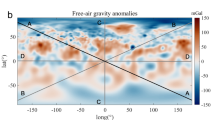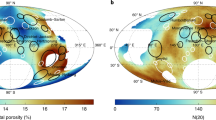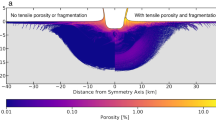Abstract
The gravity and shape data acquired by the Dawn spacecraft during its primary mission revealed that Ceres is partially differentiated with an interior structure consistent with a volatile-rich crust, a mantle of hydrated rock and isostatically compensated topography1,2,3. Detailed analyses showed that the mechanically strong crust overlays a weak, fluid-bearing upper mantle4. Previous studies, however, assumed that Ceres’s crust is a uniform layer. Here, we report findings from the new high-resolution gravity data from Dawn’s second extended mission (XM2), which reveal a complex crustal structure of Ceres. In the low-altitude regions probed by the Dawn spacecraft during the XM2 phase, we observe that gravity–topography admittance progressively shifts to a lower density solution at higher degrees, implying a radial density gradient across Ceres’s crust that is consistent with decreasing porosity with depth and/or increasing content of dense phases, such as rock and salts. That gradient brings a critical new constraint on the crustal freezing history, suggesting that the salts and silicates concentrated in the liquid phase while the crust was growing. Localized spectral analysis of the new data also shows evidence for a lower crustal density in the north polar region than in the south or near the equator, supporting impact-driven porosity variations for the observed latitudinal density differences5. On the local scale, the new data show evidence for density or rheological variations within the crust, in association with lobate landslides and ejecta deposits that were inferred to be ice-rich6,7 as well as an extensional fault system8. These inferences provide geophysical context for geological features on the surface and help us advance our understanding of the evolution of an ice-rich but heat-starved body, whose evolution was in part shaped by impacts.
This is a preview of subscription content, access via your institution
Access options
Access Nature and 54 other Nature Portfolio journals
Get Nature+, our best-value online-access subscription
$29.99 / 30 days
cancel any time
Subscribe to this journal
Receive 12 digital issues and online access to articles
$119.00 per year
only $9.92 per issue
Buy this article
- Purchase on Springer Link
- Instant access to full article PDF
Prices may be subject to local taxes which are calculated during checkout




Similar content being viewed by others
Data availability
The data that support the plots within this paper and other findings of this study are available from the PDS Small Bodies Node website (https://sbn.psi.edu/pds/resource/dawn) or from the corresponding author on reasonable request.
Code availability
We have opted not to make the code available because it is based on well-known theories for orbit and shape determinations, as described in Methods.
References
Park, R. S. et al. A partially differentiated interior for (1) Ceres deduced from its gravity field and shape. Nature 537, 515–517 (2016).
Ermakov, A. I. et al. Constraints on Ceres’ Internal Structure and Evolution From Its Shape and Gravity Measured by the Dawn Spacecraft. J. Geophys. Res. Planet 122, 2267–2293 (2017).
Konopliv, A. S. et al. The Ceres gravity field, spin pole, rotation period and orbit from the Dawn radiometric tracking and optical data. Icarus 299, 411–429 (2018).
Fu, R. R. et al. The interior structure of Ceres as revealed by surface topography. Earth Planet. Sci. Lett. 476, 153–164 (2017).
Prettyman, T. H. et al. Extensive water ice within Ceres’ aqueously altered regolith: evidence from nuclear spectroscopy. Science 355, 55–58 (2017).
Schmidt, B. E. et al. Geomorphological evidence for ground ice on dwarf planet Ceres. Nat. Geosci. 10, 338–343 (2017).
Sizemore, H. G. et al. A global inventory of ice-related morphological features on dwarf planet Ceres: implications for the evolution and current state of the cryosphere. J. Geophys. Res. Planet. 124, 1650–1689 (2019).
Hughson, K. H. G. et al. Normal faults on Ceres: insights into the mechanical properties and thermal history of Nar Sulcus. Geophys. Res. Lett. 46, 80–88 (2019).
Konopliv, A. S., Banerdt, W. B. & Sjogren, W. L. Venus gravity: 180th degree and order model. Icarus 139, 3–18 (1999).
Park, R. S. et al. High-resolution shape model of Ceres from stereophotoclinometry using Dawn imaging data. Icarus 319, 812–827 (2019).
Simons, F. J., Dahlen, F. A. & Wieczorek, M. A. Spatiospectral concentration on a sphere. Siam. Rev. 48, 504–536 (2006).
Prettyman, T. H. et al. Dawn’s grand finale: high spatial-resolution elemental measurements reveal an anomaly at Occator crater. In 50th Lunar and Planetary Science Conference 2019 2132, 1356 (USRA, 2019).
Castillo-Rogez, J. et al. Insights into Ceres’s evolution from surface composition. Meteorit. Planet. Sci. 53, 1820–1843 (2018).
Mao, X. C. & McKinnon, W. B. Faster paleospin and deep-seated uncompensated mass as possible explanations for Ceres’ present-day shape and gravity. Icarus 299, 430–442 (2018).
Raymond, C. A. et al. Impact-driven mobilization of deep crustal brines on dwarf planet Ceres. Nat. Astron. https://doi.org/10.1038/s41550-020-1168-2 (2020).
Hiesinger, H. et al. Cratering on Ceres: implications for its crust and evolution. Science 353, aaf4759 (2016).
Ruesch, O. et al. Slurry extrusion on Ceres from a convective mud-bearing mantle. Nat. Geosci. 12, 505–509 (2019).
Hughson, K. H. G. et al. The Ac-5 (Fejokoo) quadrangle of Ceres: geologic map and geomorphological evidence for ground ice mediated surface processes. Icarus 316, 63–83 (2018).
Combe, J. P. et al. Detection of local H2O exposed at the surface of Ceres. Science 353, aaf3010 (2016).
Ruesch, O. et al. Cryovolcanism on Ceres. Science 353, aaf4286 (2016).
Sori, M. M. et al. Cryovolcanic rates on Ceres revealed by topography. Nat. Astron. 2, 946–950 (2018).
Ermakov, A. I., Kreslavsky, M. A., Scully, J. E. C., Hughson, K. H. G. & Park, R. S. Surface roughness and gravitational slope distributions of Vesta and Ceres. J. Geophys. Res. Planet. 124, 14–30 (2019).
Pasckert, J. H. et al. Geologic mapping of the Ac-2 Coniraya quadrangle of Ceres from NASA’s Dawn mission: implications for a heterogeneously composed crust. Icarus 316, 28–45 (2018).
Carrozzo, F. G. et al. Nature, formation, and distribution of carbonates on Ceres. Sci. Adv. 4, e1701645 (2018).
Gregg, P. M., Lin, J., Behn, M. D. & Montesi, L. G. J. Spreading rate dependence of gravity anomalies along oceanic transform faults. Nature 448, 183–185 (2007).
Scully, J. E. C. Formation of the bright faculae in Ceres’ Occator crater via long-lived brine. Nat. Commun. https://doi.org/10.1038/s41467-020-15973-8 (2020).
Wieczorek, M. A. et al. The Crust of the Moon as seen by GRAIL. Science 339, 671–675 (2013).
Tsoulis, D. A comparison between the Airy/Heiskanen and the Pratt/Hayford isostatic models for the computation of potential harmonic coefficients. J. Geod. 74, 637–643 (2001).
Watts, A. B. Isostasy and Flexure of the Lithosphere (Cambridge Univ. Press, 2001).
Rummel, R., Rapp, R. H., Suenkel, H. & Tscherning, C. C. Comparisons of Global Topographic/Isostatic Models to The Earth’s Observed Gravity Field (NASA, 1988).
Hemingway, D. J. & Matsuyama, I. Isostatic equilibrium in spherical coordinates and implications for crustal thickness on the Moon, Mars, Enceladus, and elsewhere. Geophys. Res. Lett. 44, 7695–7705 (2017).
Sori, M. M. A thin, dense crust for Mercury. Earth Planet. Sci. Lett. 489, 92–99 (2018).
Beuthe, M., Rivoldini, A. & Trinh, A. Enceladus’s and Dione’s floating ice shells supported by minimum stress isostasy. Geophys. Res. Lett. 43, 10088–10096 (2016).
Wieczorek, M. A. & Simons, F. J. Localized spectral analysis on the sphere. Geophys. J. Int. 162, 655–675 (2005).
Wieczorek, M. A. & Meschede, M. SHTools: tools for working with spherical harmonics. Geochem. Geophys. Geosyst. 19, 2574–2592 (2018).
MacKay, D. J. Information Theory, Inference and Learning Algorithms (Cambridge Univ. Press, 2003).
Gregory, P. Bayesian Logical Data Analysis for the Physical Sciences: A Comparative Approach with Mathematica Support (Cambridge Univ. Press, 2005).
MacMillan, W. D. The Theory of the Potential (Dover, 1930).
Goodman, J. & Weare, J. Ensemble samplers with affine invariance. Commun. Appl. Math. Comput. Sci. 5, 65–80 (2010).
Acknowledgements
This research was in part carried out in part at the Jet Propulsion Laboratory, California Institute of Technology, under a contract with NASA. We thank the Dawn operations team for the development, cruise, orbital insertion and operations of the Dawn spacecraft at Ceres. Government sponsorship acknowledged. All rights reserved.
Author information
Authors and Affiliations
Contributions
R.S.P, A.S.K. and A.T.V. performed data analysis and calibration. R.S.P, A.I.E., J.C.C.-R., R.R.F., K.H.G.H., T.H.P., C.A.R., J.E.C.S., H.G.S., M.M.S., G.M., B.E.S. and C.T.R. contributed to the interpretation of the data. All authors contributed to the discussion of the results and to writing the paper.
Corresponding author
Ethics declarations
Competing interests
The authors declare no competing interests.
Additional information
Peer review information Nature Astronomy thanks Steven Vance and the other, anonymous, reviewer(s) for their contribution to the peer review of this work.
Publisher’s note Springer Nature remains neutral with regard to jurisdictional claims in published maps and institutional affiliations.
Supplementary information
Supplementary Information
Supplementary Figs. 1–10 and Tables 1 and 2.
Rights and permissions
About this article
Cite this article
Park, R.S., Konopliv, A.S., Ermakov, A.I. et al. Evidence of non-uniform crust of Ceres from Dawn’s high-resolution gravity data. Nat Astron 4, 748–755 (2020). https://doi.org/10.1038/s41550-020-1019-1
Received:
Accepted:
Published:
Issue Date:
DOI: https://doi.org/10.1038/s41550-020-1019-1
This article is cited by
-
Observational evidence for cylindrically oriented zonal flows on Jupiter
Nature Astronomy (2023)
-
Brine residues and organics in the Urvara basin on Ceres
Nature Communications (2022)
-
The Psyche Gravity Investigation
Space Science Reviews (2022)
-
Determining the Relative Cratering Ages of Regions of Psyche’s Surface
Space Science Reviews (2022)
-
Distinguishing the Origin of Asteroid (16) Psyche
Space Science Reviews (2022)



